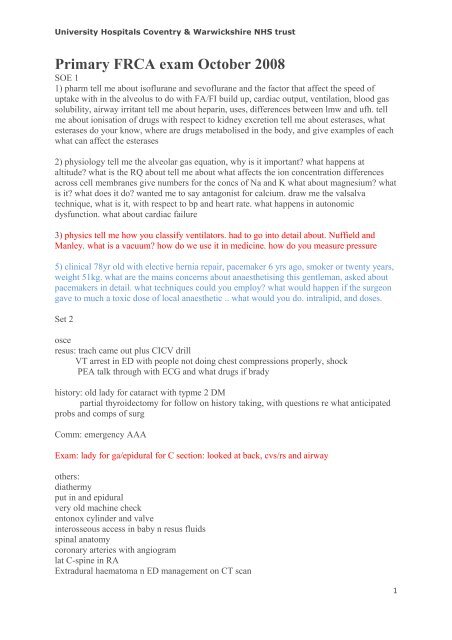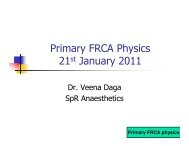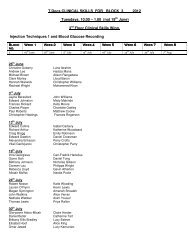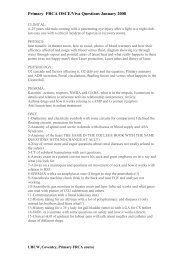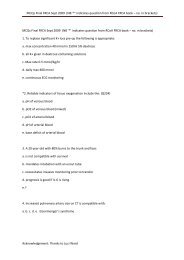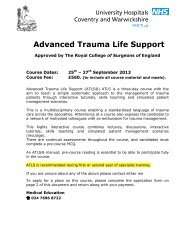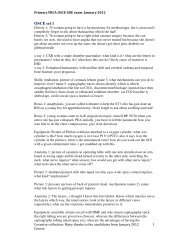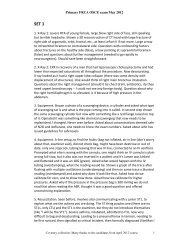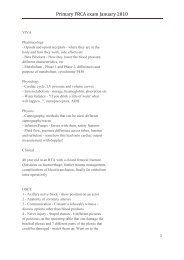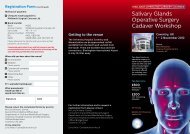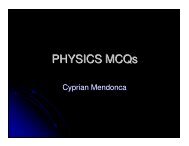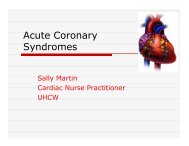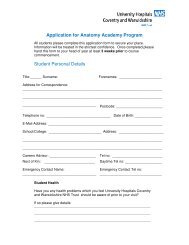Primary FRCA SOE October 2008 - MEDICAL EDUCATION at ...
Primary FRCA SOE October 2008 - MEDICAL EDUCATION at ...
Primary FRCA SOE October 2008 - MEDICAL EDUCATION at ...
You also want an ePaper? Increase the reach of your titles
YUMPU automatically turns print PDFs into web optimized ePapers that Google loves.
University Hospitals Coventry & Warwickshire NHS trust<strong>Primary</strong> <strong>FRCA</strong> exam <strong>October</strong> <strong>2008</strong><strong>SOE</strong> 11) pharm tell me about isoflurane and sevoflurane and the factor th<strong>at</strong> affect the speed ofuptake with in the alveolus to do with FA/FI build up, cardiac output, ventil<strong>at</strong>ion, blood gassolubility, airway irritant tell me about heparin, uses, differences between lmw and ufh. tellme about ionis<strong>at</strong>ion of drugs with respect to kidney excretion tell me about esterases, wh<strong>at</strong>esterases do your know, where are drugs metabolised in the body, and give examples of eachwh<strong>at</strong> can affect the esterases2) physiology tell me the alveolar gas equ<strong>at</strong>ion, why is it important? wh<strong>at</strong> happens <strong>at</strong>altitude? wh<strong>at</strong> is the RQ about tell me about wh<strong>at</strong> affects the ion concentr<strong>at</strong>ion differencesacross cell membranes give numbers for the concs of Na and K wh<strong>at</strong> about magnesium? wh<strong>at</strong>is it? wh<strong>at</strong> does it do? wanted me to say antagonist for calcium. draw me the valsalv<strong>at</strong>echnique, wh<strong>at</strong> is it, with respect to bp and heart r<strong>at</strong>e. wh<strong>at</strong> happens in autonomicdysfunction. wh<strong>at</strong> about cardiac failure3) physics tell me how you classify ventil<strong>at</strong>ors. had to go into detail about. Nuffield andManley. wh<strong>at</strong> is a vacuum? how do we use it in medicine. how do you measure pressure5) clinical 78yr old with elective hernia repair, pacemaker 6 yrs ago, smoker or twenty years,weight 51kg. wh<strong>at</strong> are the mains concerns about anaesthetising this gentleman, asked aboutpacemakers in detail. wh<strong>at</strong> techniques could you employ? wh<strong>at</strong> would happen if the surgeongave to much a toxic dose of local anaesthetic .. wh<strong>at</strong> would you do. intralipid, and doses.Set 2osceresus: trach came out plus CICV drillVT arrest in ED with people not doing chest compressions properly, shockPEA talk through with ECG and wh<strong>at</strong> drugs if bradyhistory: old lady for c<strong>at</strong>aract with typme 2 DMpartial thyroidectomy for follow on history taking, with questions re wh<strong>at</strong> anticip<strong>at</strong>edprobs and comps of surgComm: emergency AAAExam: lady for ga/epidural for C section: looked <strong>at</strong> back, cvs/rs and airwayothers:di<strong>at</strong>hermyput in and epiduralvery old machine checkentonox cylinder and valveinterosseous access in baby n resus fluidsspinal an<strong>at</strong>omycoronary arteries with angiograml<strong>at</strong> C-spine in RAExtradural haem<strong>at</strong>oma n ED management on CT scan1
University Hospitals Coventry & Warwickshire NHS trustthere was one more but ive forgotten <strong>at</strong> the mo!viva:physio: cardiac cycle, RAAS, starling forces, sodium balancepharm: local anaesthetics, antimuscarinics, g prot receptorsclinicsl: 22 year old girl right iliac fossa pain, tach and hypotensive: cause, management,hypovaolaemia crit incident, jehova witnessphysics; temper<strong>at</strong>ure control, vapourisers:des and iso, electric potentials: EEg, ECG, EMG,amplifiersSet 3I had my OSCE on 6th and the st<strong>at</strong>ions were.1.Entonox cylinder and standered questions on pressure use and supply etc,2.Intraosseous infusion ,technique and complic<strong>at</strong>ions.3.Defbrill<strong>at</strong>or and uses.4.Di<strong>at</strong>hermy and diff unipolar and biploar5.CPR adult PEA post cholecystectomy collapsed.6.History taking from 80 yrs old for c<strong>at</strong>aract surgery7.History taking from hyperthyroid pt and8.Followon st<strong>at</strong>ion9.Sim man Trachestomy tube fallen out and to manage airway.10.Epidural uses and calcul<strong>at</strong>ions off doses toxic dose.11.Examin<strong>at</strong>ion of pregnant lady with grade MP-4 and also having Scoliosis.12.Radiographs off subdural he<strong>at</strong>oma.13.Radiograph C spine14.Coronary Angigram amd questions where are wh<strong>at</strong> and wh<strong>at</strong> supply and same15.Pain p<strong>at</strong>hway and CSF pressure and volume.16.17.18.Viva sPhysiologythey asked me about Ventricular presssure curve and cardiac cycle and superimposition ofAortic curve and LAP curve.Kidney and starlings equ<strong>at</strong>ion and diff in glomerular bed and pulmonary bed.pharmocologyReceptors diff kinds and then g proteins in detaillocal anaesthetics in detailhenderson hasselbach equ<strong>at</strong>ion,cholinergic drugsuses of anticholinergic drugsclinical22 yrs old girl sudden onset on RIF pain and bp 95/45 mmhg and 120/min hrmanagement and going to massive bloodloss and correction .intraop loss and hypotension.physicstemp measurement biological potentialvaporisers bi spectral index2
University Hospitals Coventry & Warwickshire NHS trustSet 4PhysicsDead space – how to measureAn<strong>at</strong>omical – Fowler’s methodPhysiological – Bohr equ<strong>at</strong>ion and deriv<strong>at</strong>ion ofDisinfection, Decontamin<strong>at</strong>ion, Sterilis<strong>at</strong>ion.Definitions of eachTimes and temper<strong>at</strong>ures of Pasteuriz<strong>at</strong>ion and Autoclaving.Picture of two LMA’s – which one would you use (the one with stripes on indic<strong>at</strong>ingit was sterile)Blood warmersTypes and differences betweenHow would you design a blood warmer – large surface area and low flow to maximisehe<strong>at</strong> exchange. Thermistor to regul<strong>at</strong>e tempHagen Pouiseille equ<strong>at</strong>ion for flowPhysiologyCerebral blood flowMonro-Kellie doctrineGraphs of CBF changes with MAP, PaCO2, PaO2Myogenic and vasoactive theories of autoregul<strong>at</strong>ionCardiac cycleDiagram of left ventricular pressure wave. Asked to draw on aortic waveform, rightventricular pressure waveform, ECG and CVP waveform.Left ventricular flow volume loop explan<strong>at</strong>ions of and how to derive cardiac workfrom it. How loop changes in heart failureEnzymesDefinition ofExamples of enzymes – intracellular and extracellular. I used carbonic anhydrase,tyrosine kinase and pancre<strong>at</strong>ic enzymesMichaelis-Menten kineticsPharmacologyWh<strong>at</strong> factors affect speed of onset of anaesthesiaBlood:gas coefficientsOther factors – alveolar ventil<strong>at</strong>ion, cardiac output, second gas effect, FiAA.Why speed of onset quicker in children specificallyDoes size of molecule affect speed of onset – wanted to talk about XenonLog dose response curvesFull agonist, agonist with lower potency, partial agonist, agonist with competitive andnon-competitive antagonists (and examples of)Definition of an inverse agonistACE inhibitorsMechanism of actionUsesSide effectsOther drugs th<strong>at</strong> can be used in heart failure and their mechanisms of action3
University Hospitals Coventry & Warwickshire NHS trustClinical60 year old lady scheduled for emergency retinal detachment repair. Asthm<strong>at</strong>ic on inhaledsteroidsDiscussed Regional vs GAAvoidance of drugs which cause bronchospasmPONV prophylaxisOther consider<strong>at</strong>ions in eye surgery – avoid raised IOP, oculocardiac reflex.Critical Incident - Failure to bre<strong>at</strong>heMentioned relaxants and reversal, opioids and reversal, bronchospasm, hypercarbiaOSCE1. Resus – Sim man anaesthetised p<strong>at</strong>ient SV with LMA – rhythm change. Monitorshowed AF with BP 75/30. Cardioversion and wh<strong>at</strong> else to do if cardioversion didn’twork after 3 shocks (amiodarone and shock again)2. CVP – USS pictures of IJV and carotid. Asked wh<strong>at</strong> type of transducer used???Which side of neck looking <strong>at</strong>. How to make sure line in correct place and wh<strong>at</strong> iscorrect tip placement. CVP waveform waves and descents3. Resus – Just talk with examiner. Pt collapsed on ward, nursing staff doing CPR.Wanted you to confirm cardiac arrest first. Rhythm strip asystole – how would youmake sure it was true reading (check leads and gain). Management of asystolic arrestwith reversible causes4. History – 25 year old Nigerian woman for hysteroscopy. Been unwell as child andstayed in hospital, had murmur, not as tall as other siblings (not sure if they weregetting <strong>at</strong> rheum<strong>at</strong>ic fever?). Dry cough for 18 months, had recent chest x-ray in clinic5. Sim man – 16 year old elective spinal surgery still in anaesthetic room. Colleagueasking for help. MH with low SpO2, hypertension, tachycardia, high PaCO2, raisedtemp. (Only thing I forgot was to change anaesthetic machine!!)6. CXR – pulmonary venogram from p<strong>at</strong>ient hypotensive and tachycardic. Post op NOF#. Questions on management of PE.7. Airway management. – demonstr<strong>at</strong>e correct position for bag mask ventil<strong>at</strong>ion ofanaesthetised p<strong>at</strong>ient. Differences in children. Nasopharyngeal airway – complic<strong>at</strong>ionsand contraindic<strong>at</strong>ions8. An<strong>at</strong>omy – Antecubital fossa and wrist. Rel<strong>at</strong>ions of radial nerve, brachial artery anddirection it takes down the arm before branching. Rel<strong>at</strong>ions of median nerve <strong>at</strong> wrist.Where would you block the ulnar nerve <strong>at</strong> the elbow9. History follow on – 60 year old man scheduled for left hemicolectomy. Extensivecardiac history including MI 2 weeks ago as a result of bleeding. Lots of info to get inshort space of time – I ran out of time!10. CXR – 75year old lady with pansystolic murmur <strong>at</strong> apex c/o increasingbre<strong>at</strong>hlessness. (mitral regurg)11. Equipment – epidural set. Given epidural packet with hole in top and out of d<strong>at</strong>e andasked if would use (No!). How to check c<strong>at</strong>heter and filter. Size of filter and uses.Complic<strong>at</strong>ions12. Temper<strong>at</strong>ure measurement – shown picture of thermistor. Principles of thermistor.He<strong>at</strong> loss under anaesthesia. How to minimise loss through radi<strong>at</strong>ion (4 ways – Icould only think of 3)4
University Hospitals Coventry & Warwickshire NHS trust13. Axillary nerve block – show on actor positioning for nerve block. How would youperform? Derm<strong>at</strong>omes in arm. Nerves not blocked in axillary nerve block and wh<strong>at</strong>problems may it cause. (tourniquet pain)14. An<strong>at</strong>omy – autonomic nervous system. Nerve roots, ganglions and receptors.15. Communic<strong>at</strong>ion – 55 year old woman for TAH – discuss method of postoper<strong>at</strong>iveanalgesia – epidural vs PCA. Very worried about nausea and vomiting16. Examin<strong>at</strong>ion – Examin<strong>at</strong>ion of airway in man with limited neck extension. L<strong>at</strong>eral Cspine x-ray and questions on <strong>at</strong>lanto-occiptal and <strong>at</strong>lanto-axial distances17. Laser – Definition of. Laser resistant tubes. P<strong>at</strong>ient safety and personnel safety. Howlaser works. Different types of lasers (CO2, Nd-YAG, Argon)Set 6OSCE/<strong>SOE</strong> 7 th <strong>October</strong> <strong>2008</strong>VivasPhysiology/ Pharmacology1. Local anaesthetics- classify , draw linkage structure-differences between them-wh<strong>at</strong> affects lipid solubility, how does this affect potency-things affecting speed of onset & dur<strong>at</strong>ion of action-compare lignocaine and bupivacaine for the above, wanted figures2. Antacid drugs-Name different classes of drugs-Went into detail about PPIs, named examples, wanted doses-Talked about physiology of acid secretion-Why are there no anti gastrin drugs?3. Interindividual vari<strong>at</strong>ion for drug metabolism-Different reasons overall first- age, sex, genetics, organ failure-details about genetics eg: cytochrome P450, sux apnoea4. Control of respir<strong>at</strong>ion-Effectors, controller, receptors-discussed different receptors5. Vomiting-reason for vomiting-process of vomiting-difference between vomiting vs regurgit<strong>at</strong>ion-Vomiting centre, receptors there, CTZ – wh<strong>at</strong>’s different about this part of the brain,receptors there, drugs th<strong>at</strong> could act there, role of vestibular appar<strong>at</strong>us6. C<strong>at</strong>echolamines-Adrenaline vs noradrenaline, draw response on s<strong>at</strong>s probe tracing to HR and BPClinical/ Physics5
University Hospitals Coventry & Warwickshire NHS trust60 yr old for emergency retinal detachment surgery, known asthm<strong>at</strong>ic for years. Onbronchodil<strong>at</strong>ors- preassessment: wh<strong>at</strong> questions for asthma-how would you anaesthetize her, wh<strong>at</strong> to avoid-in recovery develops resp depression, wh<strong>at</strong> would you do? Asked about cause of respdepression specific to retinal detachment surgery.Physics1. Dead space-definitions, explain Fowler’s method for an<strong>at</strong>omical, derive Bohr equ<strong>at</strong>ion2. Fluid warmers- why need to warm fluid- ideal characteristics of fluid warmer- shown photos of different kinds eg: coaxial, w<strong>at</strong>er immersion, hot pl<strong>at</strong>e warmer- differences between them, narrow bore vs wide bore (leading to questions abt flow)3. Cleaning, disinfection, sterlis<strong>at</strong>ion-definitions, methods and markers used to tell if sterlis<strong>at</strong>ion completeOSCE1. Collapse on ward with asystole,-no sim man, shown asystole ECG rhythm, asked wh<strong>at</strong> you would do2. History taking-young lady for hysteroscopy for painful periods, recently migr<strong>at</strong>ed from Zimbabwe, drycough for months3. Simman 1-MH, tachy + high EtCO24. Radiology 1-pulm venogram5. Follow on history taking-70 yr old for left hemi, severe PR bleed causing MI previously, on warfarin for AF, OA ofknees taking brufen,6. Ditto7. Radiology 2-CXR cardiomegaly8. Equipment-Epidurals shown set, talk about wh<strong>at</strong> would do if could not thread c<strong>at</strong>heter9. Equipment6
University Hospitals Coventry & Warwickshire NHS trust-Temper<strong>at</strong>ure measurement, shown thermistor, asked to choose graph of resistance over timefrom selection10. An<strong>at</strong>omy 1-ACF an<strong>at</strong>omy, wrist an<strong>at</strong>omy, perform median n and ulnar nn block <strong>at</strong> wrist, radial arterycannul<strong>at</strong>ion, Allen’s test (on actor)11. An<strong>at</strong>omy 2- Brachial plexus, perform axillary block (on actor)12. Simman 2- cardiovert from fast AF12. An<strong>at</strong>omy 3-an<strong>at</strong>omy of ANS13. Communic<strong>at</strong>ion-explain post op analgesia options, esp epidurals vs PCA14. Skills-CVP line insertion using ultrasound, wh<strong>at</strong> does the transducer contain-shown images using sonosite, which side of neck is it from-how would u confirm placement-CVP waveform15. Examin<strong>at</strong>ion-airway assessment-limited neck flexion-shown c-spine l<strong>at</strong>eral, identify <strong>at</strong>lanto axial and <strong>at</strong>lanto occipital gaps16. Equipment 3-Lasers – wh<strong>at</strong> is it, wh<strong>at</strong> is it used for-safety for lasers-shown laser resistant tubes, wh<strong>at</strong> are its fe<strong>at</strong>ures, why double cuffSet 7OSCE 8/10/<strong>2008</strong>1- Epidural An<strong>at</strong>omy & demonstr<strong>at</strong>ion of technique on a manikin- Straight forward questions- Demonstr<strong>at</strong>ion on the manikin- How much lignocaine in 20 mls of 2%- How much adrenaline u need to add to the 20 mls to make it 1:200,0002- Cardiac an<strong>at</strong>omy- Layers- Pressure in RA & RV- Where are the SA & AV nodes- Blood supply of SA node7
University Hospitals Coventry & Warwickshire NHS trust- Origin of Rt & Lt coronary arteries- Venous drainage of the heart- Chordae tendinae (wh<strong>at</strong> is it made of & function)- Wh<strong>at</strong> is the sinus of valsalva- Coronary angio (to identify one of the coronary arteries)3 – Follow on History st<strong>at</strong>ion (no examiner)- 36 female for subtotal thyroidectomy- Thyrotoxic with weight loss, increased appetite, exophthalmos, irregular heartbe<strong>at</strong>s, swollen gland- No hoarsness of voice, no swallowing or bre<strong>at</strong>hing difficulties- Carbimazole & Propranolol- TFTs not checked for 4 months- No other medical history- Smoker, 2 glasses of wine/day- Allergic to septrim (rash)- Also to eggs & shellfish4- Questions on the previous history- Presenting symptoms- Radiography to request- Medic<strong>at</strong>ions- Mechanism of action of carbimazole- Name given to thyrotoxicosis with exophthalmos- Any other medical problems- Allergies- Smoking?- How many units of Alcohol?- Complic<strong>at</strong>ions of thyroidectomy5- X-ray C-spine for a p<strong>at</strong>ient with long standing Rheum<strong>at</strong>oid arthritis6- Anaesthetic machine check- Was terrible, cubicle is dark, machine th<strong>at</strong> I haven’t seen before.- Examiner is not happy- No pipelines- Anyway, went through usual routine check but wasn’t very smooth- Couldn’t find where is the power switch to start with- Oxygen & Nitrous cylinders were full- Blanking plug was available- Flowmeters working- Hypoxic guard working- Vaporiser is empty- Oxygen analyser wasn’t connected- I turned off the O2 cylinder to try to activ<strong>at</strong>e the O2 failure alarm, but it didn’twork, even though I heard it working few times.- I believe all candid<strong>at</strong>e were not happy with th<strong>at</strong> st<strong>at</strong>ion7 – Picture of Entonox cylinder- Identify- Wh<strong>at</strong> is the content- Pressure8
University Hospitals Coventry & Warwickshire NHS trust- Examiner told me the definition of the pseudocritical temp. & asked for theword itself.- Wh<strong>at</strong>’s the pseudocritical temp. of the mixture (Numerical Value)- Definition of critical temp.- Asked about the name of the 2 nd stage valve- How is the p<strong>at</strong>ient affected if the mixture is cooled below the pseudocriticaltemp.- Who else can give entonox apart from medical profession8 – Di<strong>at</strong>hermy- Showed me a neutral pl<strong>at</strong>e to identify it- Showed me a smaller one & asked if we can you use it on an adult & why not.- I had to explain about current density- Showed 2 diagrams of different circuits & asked which will be safer to use &why? (One with a flo<strong>at</strong>ing circuit)- Another picture of a p<strong>at</strong>ient touching a drip stand. Asked me about the risks &why?- Why AC & not DC- Wh<strong>at</strong> current is used- Pictures of mono & bi polar & wh<strong>at</strong> is the difference9 – Cross section of a spinal cord- Wh<strong>at</strong> are the contents of the grey m<strong>at</strong>ter- Wh<strong>at</strong>’s the dorsal root ganglion- Pain p<strong>at</strong>hway starting from dorsal horn cell to the sensory cortex- Identify the l<strong>at</strong> spinothalamic tract on the diagram- Wh<strong>at</strong>’s transmitted through the anterior spinothalamic tract- Asked me about the post. Column- Asked to identify another tract, I wasn’t sure if it is ascending or descending, Iwent for spinocerebellar tract10 – Communic<strong>at</strong>ion skills: 82 male taken to the the<strong>at</strong>re for emergency AAA. U are asked tomeet his daughter & explain about the implic<strong>at</strong>ions of th<strong>at</strong> surgery.11 – Examin<strong>at</strong>ion + History + investig<strong>at</strong>ions u need to assess a pregnant lady for either spinalor GA LSCS (didn’t say emergency or elective)- It was a bit random, and disorganised- I asked if it was her first pregnancy- I did a quick general examin<strong>at</strong>ion- Asked for BP which was 140/105- Checked for ankle oedema (Told me ankles are swollen (forgot to check forsacral oedema)- Asked about few other symptoms of pre-eclampsia- Asked about the foetus- Asked about back problems (didn’t actually examined the back, but mentionedI would)- Asked for FBC, pl<strong>at</strong>elets were 82- No protein in the urine9
University Hospitals Coventry & Warwickshire NHS trust- LFTs were normal- Assessed the airway- I wasn’t sure wh<strong>at</strong> else should I do or ask for12- PEA post cholecystectomy on the ward- No manikins or p<strong>at</strong>ients, just a ch<strong>at</strong> with the examiner- Had to diagnose PEA (ECG sinus rhythm, but pt. has no pulse)- Wh<strong>at</strong> would u do- Went through ALS Algorithm- Had to mention all the reversible causes- Wh<strong>at</strong> do u think is the most possible cause- CO is back, wh<strong>at</strong> would u do now?- Was straight forward13 – Defibrill<strong>at</strong>ion st<strong>at</strong>ion- CPR in progress on a manikin (one ventil<strong>at</strong>ing the pt, another doing chestcompression + resuscit<strong>at</strong>ion officer for the defib + the examiner)- LMA insitu- Monitor showing VF (Asked me to identify it)- Asked me wh<strong>at</strong> do u think about the CPR (compressions were slow & notproperly on the sternum)- Wh<strong>at</strong> would u do now (I said connect the defib & shock the pt.)- They <strong>at</strong>tached the leads for me and asked why we place them like th<strong>at</strong> i.e.across the heart.- Then I had to switch on the defib & shock the pt. myself- I made sure no one is touching the table; I left the oxygen as it was connectedto the LMA, which was in place.- Then asked wh<strong>at</strong> next- When would u reassess, how often u give adrenaline- Finally he’s back to sinus rhythm with a cardiac output.14 – History taking from an elderly pt. coming for a c<strong>at</strong>aract oper<strong>at</strong>ion15- Fast bleeped by the ITU nurses. Pt deeply sed<strong>at</strong>ed on a tracheostomy. Trache tube fell offwhilst transferring him. Pt. known difficult to intub<strong>at</strong>e- I went in, the nurse was panicking- Monitors on SPO2 dropping- Called for help- Other parameters were Ok, but I didn’t comment- Trolley with an laryngoscope, ETT, Guedal, Tracheostomy tube and LMA- Tried to bag & mask him while the nurse was occluding the hole, no luck- Tried to pass another another trache tube, false track- I thought to see if I can intub<strong>at</strong>e, laryngoscope hasn’t got light (I think it wassilly for me to try this anyway knowing th<strong>at</strong> he’s difficult to intub<strong>at</strong>e)- Inserted a Guedal airway & went for 2 hands technique, whilst occluding thehole, started to get some air entry- Inserted LMA, ventil<strong>at</strong>ion was much better & they stopped me there.10
University Hospitals Coventry & Warwickshire NHS trust- Asked me how else can u sort out his airway. I said we could do anothercricothyroidotomy.- I am not sure why I didn’t go for the LMA from the start.16 – CT head with an extradural hge- Straight forward questions17- Checking an invasive arterial BP monitoring- 18 G venflon- Long compliant tubing- Air bubbles- 5% glucose- Not pressurised- Asked wh<strong>at</strong> is the effect of each of these faults- How to zero the transducer- How to calibr<strong>at</strong>e it to higher pressure- Showed me a picture of over damped arterial wave form & asked how wouldit affect the readings18 – Intraosseous injection- Demonstr<strong>at</strong>ion on the manikin- Indic<strong>at</strong>ions- 2 sites for insertion- 3 Complic<strong>at</strong>ions- How would u give fluid through this route- How to estim<strong>at</strong>e the weight of a child- How much fluid bolus- Maintenance fluid in a 10 Kg child<strong>SOE</strong> 8/10/<strong>2008</strong>Clinical ScenarioMiddle aged female with long standing crohn’s disease coming for pan-proctocolectomy.Recent abdominal pain, diarrhea and pyrexia. She is on Prednisolone 7.5 mg as well asSulphasalazine & Az<strong>at</strong>hioprine.- Wh<strong>at</strong> are ur concerns about this lady.- P<strong>at</strong>ho-physiology of crohn’s- Is it familial?- Relevant problems (I mentioned about obstruction, perfor<strong>at</strong>ion, electrolytedisturbance, sepsis, side effects of drugs)- Asked about side effects of steroids i.e. didn’t ask about Sulpha orAz<strong>at</strong>hioprine, Thank God.- Then asked how would u anaesthetise her?- Wh<strong>at</strong> monitoring (I said the basic staff + A-line + Urinary c<strong>at</strong>heter), forgot tomention the temp.11
University Hospitals Coventry & Warwickshire NHS trustPhysics:1 – Defibrill<strong>at</strong>or- Wh<strong>at</strong> position she would be in during surgery.- Wh<strong>at</strong> are the causes of postop oliguria (Pre-renal, renal & postrenal)- Wh<strong>at</strong>’s olguria- Wh<strong>at</strong> drugs we give th<strong>at</strong> can affect the renal function- The nurse called you because the epidural is not working. Wh<strong>at</strong> would u do?- Large volume low conc. Vs small volume high conc. Bupivacaine- Wh<strong>at</strong> is a capacitor, how does it work?- Wh<strong>at</strong> factors influence the capacitance?- Difference between AC & DC- Definition of Coulomb- Asked to draw the defib. Circuit.- Showed me graphs of the current flowing in the circuit versus time2- LASER- Safety measures- Components of laser- How does it work- Types of Laser- Indic<strong>at</strong>ions3 – Supraglottic devices- Different types of LMAs- Sizes & weight range for each size- Advantages- Disadvantages- Wh<strong>at</strong> airway devices u can use for difficult intub<strong>at</strong>ion (Bell rang)Physiology1- Blood Gases: PH 7.1 , Pco2 12 , Po2 15.5- Wh<strong>at</strong>’s wrong with these gases- Wh<strong>at</strong>’s the normal range for each- Why is the Po2 high- Wh<strong>at</strong>’s the H ion conc. <strong>at</strong> th<strong>at</strong> PH- Wh<strong>at</strong> are the compens<strong>at</strong>ory mechanisms?- How is th<strong>at</strong> pt. clinically?2- Autonomic nervous system- Compare between symp. & parasymp.- I started with an<strong>at</strong>omical differences- Asked to compare receptors & neurotransmitters- Then effects on different systems- Mainly CVS & GIT12
University Hospitals Coventry & Warwickshire NHS trust3- Total Body Fluid- Started with distribution of TBF- Electrolytes- Movement of electrolytes- Osmotic effect- Wh<strong>at</strong> happens if we transfuse 2 L of Normal Saline- Had to mention also about barorecptors, <strong>at</strong>rial receptors & ANPPharmacology1- IV Anaesthetic agents- Different classes- Wh<strong>at</strong> is the difference between different barbitur<strong>at</strong>es- Mechanism of action of Thiopentone- Had to explain about GABA receptors- Mechanism of action of Ketamine- Had to explain about NMDA receptors- Why do anaesthetist prefer propofol over Thiopentone2 – Pharmacokinetics- Plasma conc. vs time curve after IV injection- Equ<strong>at</strong>ion- Had to explain about exponential function- Logarithmic scale- 1 st & zero order kinetics- ½ life & time constant3 – ColloidsSet 8<strong>SOE</strong> 1:PHYSIOLOGY- Different types- Molecular weight- Mechanism of action- Which one stays long in the IV compartment, starch or Gel<strong>at</strong>in? & Why?- Side effects- How do they interfere with coagul<strong>at</strong>ion?1) Compliance,13
University Hospitals Coventry & Warwickshire NHS trust· define, types, st<strong>at</strong>ic vs dynamic, Which pressure increases, definitions of all thepressures involved eg transpulmonary, intrapleural,· compliance curve, draw, wh<strong>at</strong> will happen in restrictive and obstructive diseases tothis crve.· Work of bre<strong>at</strong>hing, why is expir<strong>at</strong>ory work less, why hysteresis.2)Adrenal Gland,· an<strong>at</strong>omical layers and· secretions layers wise· control of all those hormones by drawing the axis and explaining along with th<strong>at</strong>.3)Body w<strong>at</strong>er distribution….· Normal distribution in detail with percentages and volumes· difference in neon<strong>at</strong>e,· 1 L of w<strong>at</strong>er orally, ...physiological effects· 1L of Normal Saline intravenously, effects.Wanted to hear wh<strong>at</strong> eill happen to ADH and baroreceptors in each case.PHARMACOLOGY:1)Non depolarizinfg Musclerelaxants,· Classify,· Wh<strong>at</strong> effects the onset of action of Non depolarizing Muscle relaxants.· Wh<strong>at</strong> effects the offset of action of Non deporalizing Muscle relaxants.· Can you name some other drugs which can act as a mucle relaxant.2)Routes of drug administr<strong>at</strong>ion,· Name all the roués f drug administr<strong>at</strong>ion you are aware of· Wh<strong>at</strong> is the purpose of all these routes,· Factors effecting Oral Route,Bioavailability definition,Curve.3)Drugs sed in Asthma,14
University Hospitals Coventry & Warwickshire NHS trust· Classify.· How does Salbutamol Work.(wanted all the Gs protien mechanism)· Tell me about the side effects of Phosphodiestrase inhibitors.<strong>SOE</strong> 2:Clinical:Scdenario: an 18 year old fell off the bike,presenting with a rigid abdomen, how will youproceed.1) Surgeons want to take him to the<strong>at</strong>re immedi<strong>at</strong>ely, how will you assess his blood loss.· All THE CLINICAL PARAMETERS, WHAT WILL HAPEN TO THEM IF HEHAS LOST 20 % of his circul<strong>at</strong>ing volume.· How will you manage this case Anaesthetically.· Go through the steps of Rapid Sequence Induction.· How will you resuscit<strong>at</strong>e him.· How will you improve his oxygen carrying ability?Blood transfusion· Defin Massive Blod Tranfusion· wh<strong>at</strong> are the complic<strong>at</strong>ions associ<strong>at</strong>ed with massive blod transfusion.· Enumer<strong>at</strong>e each, asked more about infective complic<strong>at</strong>ions.Critical incident: ABO incomp<strong>at</strong>ibilty reaction, wh<strong>at</strong> will you do,How do you perform the checks when tranfusing blood to some one.Postoper<strong>at</strong>ive management of this case.Pain Relief Options for this case.PHYSICS:1)ELECTRICITY15
University Hospitals Coventry & Warwickshire NHS trust· All the electrical symbols(i.e all cmmon one which we see in books).· Few definitions: resistance, Ohms law with equ<strong>at</strong>ions,.... Rel<strong>at</strong>e through an equ<strong>at</strong>ionrel<strong>at</strong>ion between power, resistance and current.· Define Capacitence, capacitor.ive an example of device whih uses capacitor.· Wh<strong>at</strong> does Diode do.(was not s<strong>at</strong>isfied with my definition th<strong>at</strong> converts AC into DCcurrent)· Define AC and DC current.· Draw and AC waveform, and superimpose on it a DC wave form.2)LOW Flow Anaesthesia:· define,· wh<strong>at</strong> are the advantages,· wh<strong>at</strong> are the disadvantages.· Components of a Circle System.3)Questions rel<strong>at</strong>ed to he<strong>at</strong>:· Define boiling point,· define freezing point.· Q: a graph was shown in which ice was melting into w<strong>at</strong>er and then boiling intovapour, <strong>at</strong> the st<strong>at</strong>e of change of phase tempr<strong>at</strong>ure was remaining constant, wanted meto explain the definitions of L<strong>at</strong>ent he<strong>at</strong> of vaporiz<strong>at</strong>ion and fusion <strong>at</strong> this stage.· Define triple point of w<strong>at</strong>er.· Shown 3 graphs of N2O cylinder emptying, one in which pressure remainingcostant, another in which pressure dropping with time....didnt get tho this thirt one...asbell rang.OSCE:1)History: 33 year female, for varicose vein surgery, has got asthma.2)SIMMAN: cant intub<strong>at</strong>e cant ventil<strong>at</strong>e scenario in a RSI.3)Radiology: enlarged heart and Q rel<strong>at</strong>ed to th<strong>at</strong>16
University Hospitals Coventry & Warwickshire NHS trust4)Radiology L<strong>at</strong>eral Chest Xray showing hi<strong>at</strong>us herna, and questins rel<strong>at</strong>ed to th<strong>at</strong>5)ANATOMY: Rib, and first rib, questions on chest drain, insertin site, demonstr<strong>at</strong>ehow will you do needle decompression in a tension oneumothorax.6)ANATOMY: Orbit, Structures passing through supra and infra orp fissure, and opticcanal., and cribriform pl<strong>at</strong>e, Facial Fracturesclasific<strong>at</strong>ion(three tyes).Direction of needle in a peribulbar eye block.Complic<strong>at</strong>ions of eye block.7)Machine Check8)PH electrode and every thing about th<strong>at</strong> ( labelling of everything on the diagram withquestions rel<strong>at</strong>ed to th<strong>at</strong>)9)Skills: Epidural insertion10)History11)History Follow on : Young P<strong>at</strong>ient who had Porphyria. In History follow on most ofthe st<strong>at</strong>ion consisted of proper viva type questions with all the aspects of porphyria.very little was asked specifically rel<strong>at</strong>ed to the history of p<strong>at</strong>ient.12)Resuscit<strong>at</strong>ion: young lady with a PEA Arrrest folloing ruptured ectopic pregnancy.13) Resuscit<strong>at</strong>ion: Tachycardia, unstable, stable…almost 90 % of the algorithm wasasked.14) Pulsoximeter: various questions and graphs rel<strong>at</strong>ed to th<strong>at</strong>(seemed quite straightforward)15) Needle stick injury , all the questions rel<strong>at</strong>ed to th<strong>at</strong> egwh<strong>at</strong> will you do following a needle stick inj,who will you report <strong>at</strong> wh<strong>at</strong> time,wh<strong>at</strong> will you do with the p<strong>at</strong>ient,wh<strong>at</strong> will happen to your bloods,sero conversion,incidence of HIV after needlestick injury from a high risk p<strong>at</strong>ient.Wh<strong>at</strong> is the difference in incidence if you get a prophylaxisDrugs used for prophylaxis16) Communic<strong>at</strong>ion: P<strong>at</strong>ient postponed for surgery.17) Airway management: various views of laryngoscopy on cards. Various capnographytraces. Laryngoscopes, various blades and indic<strong>at</strong>ions.17
University Hospitals Coventry & Warwickshire NHS trust18) JVP measurement:actual method,demonstare hep<strong>at</strong>o jugular reflex.Wh<strong>at</strong> heppnes <strong>at</strong> a wave, and v wave.Conditions with increased JVPConditions with large a waves, Large v W#SET 9Clinical - 60 yr old lady for emergency retinal detachment surgery. PMH asthma onsalbutamol and steroids. Viva went on assessment of asthma on history, then investig<strong>at</strong>ionsand anaesthetic management and effects of steroids. Fisnished in 10 min. So he asked aboutPONV. Causes and management.Physics - Measurement of Dead space. Specifically asked about how do we measure volumeon the graph of N2 conc versus volume graph and to mark exact percentage of N2 on Y axis.Next he showed 2 LMA in a bag and asked which on I was happy to use. One had thestripedautoclave indic<strong>at</strong>or strip. Then the Viva went on decontamin<strong>at</strong>ion, disinfectants, sterilis<strong>at</strong>ionasked about percentages of chlorhexidine and about pasteauris<strong>at</strong>ion.Third question was on blood warmers and wh<strong>at</strong> properties would you like the giving set tohave.Pharma - local anaesthetics - about differences of amides and esters, mechanism of action,toxicity of bupivacaine and lignocaine. factors causing variability in drug response.physiological and genetics their effects on pharmacokinetics from there. about sux apnea. lastquestion was antacids. types and mechanism of action.Physio - control of bre<strong>at</strong>hing straight forward. showed the box concept of receptors,modul<strong>at</strong>ors and effectors.adrenergic receptors. all about them. and last was nausea and vomitting. again asked to drawthe box concept.OSCE - X-ray of pulmonary angiogram -Xray 2 was LVH I think anyways.History follow on for lt hemicolectomy and was on warfarin.history 2 was Afrocarribean for TAH. Came to his country 5 yrs back and hadrheum<strong>at</strong>ic fever in childhood. and no sickle cell trait.Equipment was temp monitor and Epidural set.An<strong>at</strong>omy of Arm. mainly ACF and wrist and al the blocks.Examin<strong>at</strong>ion of Airway.Technical skills Management of airway.Sim man - MH and New onset AF.resus st<strong>at</strong>ion ALS rpotocol.surface an<strong>at</strong>omy of axillary block.CVP line, waves and last question was 4 clinical ways of knowing th<strong>at</strong> tip is in thecorrect position. I said about Xray, CT. but He said clinical. Don't know wh<strong>at</strong> he expected.cant remember the last two st<strong>at</strong>ions.18
University Hospitals Coventry & Warwickshire NHS trustSet 10<strong>Primary</strong> <strong>FRCA</strong> 8 th Oct <strong>2008</strong> VivasClinical27-year-old man has an eye injury following a fight outside a nightclub, questions aboutmanagement, assessment, etcAnaphylaxis on inductionDusky colour, decreased s<strong>at</strong>s in recovery - how would you deal with if you hadn'tanaesthetised the p<strong>at</strong>ient, failure to bre<strong>at</strong>he, inadequ<strong>at</strong>e reversal, etcPhysicsBlood pressure management on a ward - Oscillotonometer, DINAMAPCollig<strong>at</strong>ive properties, osmotic pressure, osmolarity, osmolality, why we measureCylinders - testing, nitrous oxide cylinder picture (incl PIN index), pressure curve fornitrous oxide cylinderPhysiologyLV pressure/volume, Starling's lawBlood - constituents, types of WBC, structure of RBC, functionsCentral chemoreceptors, alveolar gas, Arterial pO2 if you go up a mountainPharmacologyWh<strong>at</strong> is MAC, why is it useful, wh<strong>at</strong> does it do, Meyer overtonTell me about diazepam and it's metabolism. Where in body are drugs metabolised?wasn't s<strong>at</strong>isfied with liver, kidney, plasma?? Cyp450, isoenzymesHeparin - everything, LMW vs unfraction<strong>at</strong>ed. Then onto when do you give heparin inthe<strong>at</strong>re, etc, DVT etc.OSCE1 Communic<strong>at</strong>ion - PDPH headache in pregnant lady2 Clinical: Examin<strong>at</strong>ion - Arterial pulses, praecordium and heart sounds, with a fewquestions3 Clinical: Cricoid - demonstr<strong>at</strong>e on model, discuss how you would tell ODP to do it,amount of pressure to use, when to apply, when not to.4 An<strong>at</strong>omy: Brachial plexus questions5 Clinical: pictures of different positions (arm extended, neck extended,trendellenberg), picture of brachial plexus, pick the nerve th<strong>at</strong> would be damaged witheach.6 Resus - Cardioversion of Pulsed VT7 Equipment - Vapourisers: rubbish drawing of Plenum vapouriser, talking about SVP,in/out of circle, concentr<strong>at</strong>ions, if you go up a mountain, etc, advantages/disadvantagesover Boyle's bottle, etc8 Resus - just an ECG rhythm strip of sinus brady then talk through9 History taking -man for TURP10 Sim-man: aspir<strong>at</strong>ed in the<strong>at</strong>re, called by ITU F1 because decreased s<strong>at</strong>s - tube was intoo far11 Radiology - CXR - questions12 History - young man for CT head under GA (claustrophobia) - asthm<strong>at</strong>ic13 Recounting history - they ask questions: wh<strong>at</strong> is he having CT head for, wh<strong>at</strong> sx, whyGA, asthma, GA hx, drugs allergies, Peak flow th<strong>at</strong> day, etc19
University Hospitals Coventry & Warwickshire NHS trust14 Foetal circul<strong>at</strong>ion: name parts on bad diagram, then answer questions, incl adultremnant of Ductus arteriosus15 Clinical - assess airway of actress, then questions incl photo of a tongue to giveMalamp<strong>at</strong>ti to, c-spine x-ray to look <strong>at</strong> and comment on16 Radiology - CXR with pacemaker and questions17 Equipment - Magills, laryngoscope blades plastic vs metal, curved vs straight18 Equipment - line diagrams of Clark electrode, fuel cell and paramagnetic O2 analyserthen questionsSet 11Pharmacology/ PhysiologyFent & AlfentWhen would you use each of them?Wh<strong>at</strong> factors determine their onset of action and elimin<strong>at</strong>ion ie pKa; protein binding; lipidsolubility.Wh<strong>at</strong> is the link between pKa & degree if ionis<strong>at</strong>ion.Could you define volume of distribution.Wh<strong>at</strong> factors determine it?Could you define Context sensitive half time.Could you draw me a graph indic<strong>at</strong>ing how the half lives of fent; alfent and Remi vary withthe dur<strong>at</strong>ion of infusion.Could you me about the renal elimin<strong>at</strong>ion of drugs.I divided this into filtr<strong>at</strong>ion and secretion.Wh<strong>at</strong> factor determine whether a drug is filtered or secreted. ie MW, protein binding, chargeand lipid solubility.Could you classify Anti – convultants.Tell me about GabapentinUses; Mechanism of action; Doses!!Phenytoin- Tell me about its elimin<strong>at</strong>ion kinetics.PhysiologyGiven a set of gases showingPh of 7.3 and Pa CO2 OF 4.0Asked to explain the possible causes of this. Wh<strong>at</strong> would you expect the HCO3 results toshow in an acute situ<strong>at</strong>ion.Wh<strong>at</strong> factors determine alveolar ventil<strong>at</strong>ion.Could you draw me a graph showing the link between alveolar Pa CO2 and minuteventil<strong>at</strong>ion.Wh<strong>at</strong> is the blood flow to the kidney/min.Wh<strong>at</strong> is the GRF/min and URINE output/min.Wh<strong>at</strong> factor determine Renal perfusion.How does the kidney auto- regul<strong>at</strong>e its perfusion.ie Myogenic and Neural control.Asked to draw juxta-glomerular appar<strong>at</strong>us and explain physiological role of macula densa.20
University Hospitals Coventry & Warwickshire NHS trustSet12Clinical Scenario75y Male.Known COPDDue for Urgent HaemorrhoidectomyNo other notes or info availableHow would you manage himPre – op assessmentHow would you assess severity of COPDBed side tests.Other IxWh<strong>at</strong> would you expect his gases to show.Talked about possibility of Regional / GA anaesthesiaWh<strong>at</strong> potential complic<strong>at</strong>ions could arise in a COPD pt with invasive ventil<strong>at</strong>ionIn Recovery area post extub<strong>at</strong>ion the p<strong>at</strong>ient goes into larygospasm.How would you manage this.How you manage pain relief in a p<strong>at</strong>ient.How do you assess pain relief in a p<strong>at</strong>ient.Wh<strong>at</strong> different methods providing op analgesia are you aware of. Tell me about the risks/benefits of each.PhysicsDefine SVP.Wh<strong>at</strong> factors determine it?Could you draw me a graph showing the correl<strong>at</strong>ion between SVP and temp.Wh<strong>at</strong> is the SVP of SEVO, ISO & DESShown a TEC 5 vaporiser. Asked to explain its mechanism of action.Talked about temp compens<strong>at</strong>ing mechanisms, wicks, splitting r<strong>at</strong>io and then specificfe<strong>at</strong>ures of TEC5.Shown TEC 6 vaporiser. Asked why DES couldn’t be used in a TEC 5 vaporiser.Asked about specific fe<strong>at</strong>ures of TEC 6 ie differential pressure transducer and pressurereducing valve.Tell me about the ways of reducing the<strong>at</strong>re pollution.Briefly talked about regional anaesthesia; TIVA & circle system.Then asked about scavenging.Active and passiveAsked about Cardiff aldsorber.Fe<strong>at</strong>ures of active scavenging systems.Tell me about ultrasoundUses. How the waves are produced.Do you know the eqn for Doppler/ultrasound.21
University Hospitals Coventry & Warwickshire NHS trustWh<strong>at</strong> is the Doppler effect. How can we use this to determine CO.Could you tell me about trans- oesophageal echocardiography.-------------------------------------------------------------------------------------------------------OSCE.1.) SIM Man - M.H. scenario2.) Hx taking st<strong>at</strong>ion from a young female due for a laparoscopy for lower abdominal pain.She had an illness as a child which left her with a heart murmur. She recently emigr<strong>at</strong>edfrom Africa. She c/o increasing SOB on exertion over the past two months.3.) Shown uss image of RIJ. Asked about CVP waveform and CVP cannul<strong>at</strong>ion.4.) Resus scenario – AF with fast Vent response requiring electrical cardioversion.5.) Airway st<strong>at</strong>ion – asked to assess airway of a man in pre-op scenario. Then asked toreview his l<strong>at</strong>eral c-spine6.) Shown ETT used in LASER surgery. Key fe<strong>at</strong>ures ie double cuff filled with salineand metalAsked about uses of laser therapy. Briefly about mechanism of laser gener<strong>at</strong>ion.Safety precautions during use for both p<strong>at</strong>ients and oper<strong>at</strong>ing staff.Shown a clear set of goggles and asked if they would provide protection against co2 lasertherapy.7.)An<strong>at</strong>omy St<strong>at</strong>ion. Para & Symp nervous system. Receptors, neurotransmitters and nerveroots.8.) Axillary Nerve block. Technique.Then shown a picture of arm and asked to point out certain derm<strong>at</strong>ome levels.9.) Temp. Asked about nasopharngeal temp probe. Principle behind it.Asked for definition of CORE body temp; Triple point of w<strong>at</strong>er; Kelvin andscale. He<strong>at</strong> loss in surgery and methods of preventing it.celcius10.) Epidural st<strong>at</strong>ion. Risks. Check equipment and explain purpose of each.11.) X-Ray showing cardiomegaly.12 & 13.) Hx and present<strong>at</strong>ion of a case.55yr Male due for hemi-colectomy. MI 5 YRS ago. AF. Failed DC cardioversion.Further MI 6 weeks ago.IHD. OA both knees.On Warfarin.14.) An<strong>at</strong>omy of antecubital fossa – nightmare st<strong>at</strong>ion. Loc<strong>at</strong>ion of biceps tendon, ulna nerve.Allens test and details. Names of muscles around ulna nerve.22
University Hospitals Coventry & Warwickshire NHS trust15.) Airway management st<strong>at</strong>ion. Shown a dummy. Asked how I would optimise the airwayfor facemask ventil<strong>at</strong>ion. Airway optimis<strong>at</strong>ion for a child.Shown nasopharyngeal airway and asked about uses risk and C.I.16.) X-ray taken post contrast injection into the pulmonary vascul<strong>at</strong>ure in a p<strong>at</strong>ient with aP.E.Asked a few questions concerning management of P.E.Set 13<strong>October</strong> <strong>2008</strong>OSCE1. An<strong>at</strong>omy of the Rib and Rel<strong>at</strong>ions of the first rib.Surface an<strong>at</strong>omy of trachea on chestHow perform intercostal block and complic<strong>at</strong>ions2. L<strong>at</strong>eral CXR: Hx cough, SOB. Planned surgery of empyema.- I think it was collapse/ consolid<strong>at</strong>ion with a prominent breast shadow- questions rel<strong>at</strong>ed to management and whether fit for surgery3. Machine check - no blanking plug, no second oxygen cylinder, no b<strong>at</strong>tery in oxygenanalyser, leak in back bar4. ABG Electrodes - classic severinghaus electrode picture from Parbrook and then picture ofall three electrodes in ABG machine from Parbrook but altered slightly - bit confusing buteveryone found hard. Once worked out wh<strong>at</strong> it was, a fairly standard question5. Resus : Ectopic. Initial management, PEA arrest, definitive management of taking tothe<strong>at</strong>re.6. Communic<strong>at</strong>ion: P<strong>at</strong>ient cancelled due to emergency - apologise etc.7. Needle Stick injury-- Wh<strong>at</strong> to do in the event – who you contact- Risk of HIV-Name a drug used in PEP- by how much does PEP reduce your risk and who else would you contact - apparentlyanswer health and safety8. Epidural - an<strong>at</strong>omy and insertion9. Pulse Oximeter - straight from book10. CXR - globular heart in p<strong>at</strong>ient. Hx Rheum<strong>at</strong>ic Fever11. History - P<strong>at</strong>ient with Porphyria. You had to specifically ask about skin and liverproblems or the actor did not declare them. Even if asked how it affects him or wh<strong>at</strong> type ofPorphyria he has.23
University Hospitals Coventry & Warwickshire NHS trust12. History - Varicose vein surgery in an asthm<strong>at</strong>ic13. Examin<strong>at</strong>ion - JVP, describe JVP waveform and wh<strong>at</strong> happens, abnormalities etc14. SimMan - difficult intub<strong>at</strong>ion - cannot intub<strong>at</strong>e, cannot ventil<strong>at</strong>e scenario15. Discuss difficult intub<strong>at</strong>ion manoeuvres - blades, positioning etcShown different capnography traces - asked when would occurHow can you confirm oesophageal intub<strong>at</strong>ion? Clinically as well as CO2 etc rel<strong>at</strong>ed16. Skull - ethmoid, SOF and Orbital canalPeriorbital block and complic<strong>at</strong>ionsVIVA:PHYSIO/PHARM1. Vol<strong>at</strong>ilesDesflurane + Sevoflurane - Wh<strong>at</strong> type of compounds + draw structureTalk about properties - blood/gas, oil/gas/ MAC/Metabolism and wh<strong>at</strong> they represent2. PharmoacokineticsConcentr<strong>at</strong>ion-Time curve - exponential equ<strong>at</strong>ionClearance/Volume of distribution + equ<strong>at</strong>ion linking themHow can you use graph to calcul<strong>at</strong>e themTime constant/ Co/ Zero order and first order kinetics - wh<strong>at</strong> are and how graph represents+ examples of drugs3. Resus drugs - Adrenalin/Atropine/Amiodarone/MagnesiumHow adrenalin worksWhen do you use drugs in algorithmWh<strong>at</strong> is the evidence behind their use4. Starling Forces - Net filtr<strong>at</strong>ion - how varies between blood/Pulmonary/Renal circul<strong>at</strong>ion5. Thyroid hormone - Synthesis, Receptor action. How thyroxine worksCalcitonin and mechanism of action6. V/Q R<strong>at</strong>ios - units/Shunt/dead space- Fowler Method- Bohr equ<strong>at</strong>ionClinical/ Physics68 year old smoker, XS ETOH with Burns to chest, face and arms. Fallen in blaze.How would you assessUse of suxamethonium and burnsDifficult intub<strong>at</strong>ion incidentEffects of smoking and liver problems on anaesthesia24
University Hospitals Coventry & Warwickshire NHS trustPhysics1. Venturi and Coanda effectExamplesExtraction r<strong>at</strong>ioGiven figures to calcul<strong>at</strong>e2. Humidity - why is it importantways of measuringShown picture of regnaults hygrometer - how does it workWays of humidifying - HME/Nebuliser/W<strong>at</strong>er B<strong>at</strong>h + how workProblems associ<strong>at</strong>ed with humidific<strong>at</strong>ion3. Measurement of vol<strong>at</strong>iles- IR --> how does it work/wh<strong>at</strong> interferes with measurement- How does mass spectrometry work- How does Raman sc<strong>at</strong>tering workSet14viva PhYSICS AND CLINICALS1. Wh<strong>at</strong> is a capacitor , Define farad. Defibrill<strong>at</strong>or Diagram Uses . How is the chargeincreased . Wh<strong>at</strong> is the use of inductor ?2. Does Inductor allow AC/ DC current to pass through ? Why3. Wh<strong>at</strong> is impedence ?,can a capacitor allow an AC current to pass through4.Laser definition, Uses Principles , Hazards . Prevention,5 Differnce between LMA and ETT wh<strong>at</strong> is the advantages in using LMA over ETT ? wh<strong>at</strong>are the different type LMAClinicalsA 34 yr old female booked for an emergency panproctocolectomy for known crohns diseaseand is pyrexial and is having diarrohea . She is on tre<strong>at</strong>ment with prednisolone 7.5mg/day ,sulphasalazine, and methotrexte .Wh<strong>at</strong> are the problems you encounter in this p<strong>at</strong>ientWh<strong>at</strong> type of anaesthesia do you chooseWh<strong>at</strong> other differnt organs th<strong>at</strong> the disease affectwh<strong>at</strong> are the effect of steroids associ<strong>at</strong>ed with the problemshow will resuscit<strong>at</strong>e the p<strong>at</strong>ients intraoper<strong>at</strong>ivelyassuming the p<strong>at</strong>ient having and epidural and working in effectively , How do you managethe problemPost op managementViva -Physiolgy25
University Hospitals Coventry & Warwickshire NHS trust1. ph -7.1, po2 15.5 kpa, pco2 12kpa, Wh<strong>at</strong> is the diagnosis ?Do you need any other parameters to diagnose ?Explain acid base balance in the bodyHow is the normal values of acid and base derived2. Explain the ANS ,Differnce between symp<strong>at</strong>hetic and para symp<strong>at</strong>hetic nervous system and its effects onvarious organs of the body3. If you infuse 2 l of Normal saline tell me about the physiolgy th<strong>at</strong> affect . tell me aboutTBW, ECF and ICF volumesViva- Pharm1.Draw the structure of thipentone and explain how the substitution with various <strong>at</strong>om changethier characteristics?2. Tell me about propfol ,ketamine and etomid<strong>at</strong>e3How is thipentone distributed in the body draw the exponential graph4.Draw the Plasma conc versus time for the thipentone wh<strong>at</strong> order kinetics does it followWh<strong>at</strong> are the differnt types of kinetics do you know , explain with example and graphExplain the first compartmental model, second and third compartment model, explain thecantenary and mamilary model and equ<strong>at</strong>ion for the second and third compartmental model5.Wh<strong>at</strong> type of colloid do use ?tell me about the gel<strong>at</strong>in, hetrastarch, dextran, osmolality, PH, Metaboilism and effect on thebodyWh<strong>at</strong> are the other means of carrying haemoglaobin explain?Set15I am pleased to inform you th<strong>at</strong> I have passed the <strong>Primary</strong> <strong>FRCA</strong> exam successfully.The following are the set of questions /st<strong>at</strong>ions for the osce held on 9th october:St<strong>at</strong>ion 1: Rhythm strip of asystole ...Questions rel<strong>at</strong>ed to resuscit<strong>at</strong>ionSt<strong>at</strong>ion 2: History taking 25 year old lady for laproscopy , day case surgery, had a heartmurmur, not had any tests done.Had sore thro<strong>at</strong> in childhood and had stiff joints and nodulesthen.St<strong>at</strong>ion 3: Simul<strong>at</strong>ion st<strong>at</strong>ion :P<strong>at</strong>ient given propofol 200 mg i.v , followed by 8mgvecuronium and presently being ventil<strong>at</strong>ed with O2:N2O and sevofluraneHigh etco2 , Malignant hyperthermia.St<strong>at</strong>ion 4:xray : pulmonary embolism.St<strong>at</strong>ion 5:history taking & follow on 65 year old gentleman for right hemicolectomyfollowing bleeding p.r26
University Hospitals Coventry & Warwickshire NHS trustHe was on warfarin for <strong>at</strong>rial fibrill<strong>at</strong>ion, frusemide, digoxin , nsaids for arthritis .he had a MI1 MTH back & has had sync cardioversion for fast AF 5 YEARS back.They asked about family history -2 brothers died of MI, and pharmacological interactions.St<strong>at</strong>ion 6: Xray : Straight left heart border, 70 year old lady with chest pain & bre<strong>at</strong>hlessnessfor a hip replacement .she also has a murmur.St<strong>at</strong>ion 7:Epidural kit and questionsSt<strong>at</strong>ion 8 : Temper<strong>at</strong>ure measurement , graphs shown.St<strong>at</strong>ion 9:Antecubital fossa ( an<strong>at</strong>omy ) on live p<strong>at</strong>ientSt<strong>at</strong>ion 9:Axillary block ( an<strong>at</strong>omy & technique ) -live p<strong>at</strong>ientSt<strong>at</strong>ion10:AN<strong>at</strong>omy -Symp<strong>at</strong>hetic & parasymp<strong>at</strong>hetic nervous systemSt<strong>at</strong>ion 11:AIRWAY examin<strong>at</strong>ionSt<strong>at</strong>ion12: Laser tubes & safety questions,principle of laserSt<strong>at</strong>ion 13: bag mask ventil<strong>at</strong>ion on manikinquestions rel<strong>at</strong>ed to airway managementSt<strong>at</strong>ion 14:cvp trace & ultrasound questionsSt<strong>at</strong>ion 15:Safe defibrill<strong>at</strong>ion for fast Atrial fibrill<strong>at</strong>ionSet 16OSCE: (tricky)1a History: Porphria / Allergy penicillin. For elective surgery Take history anddocument1b History: follow on – details about p<strong>at</strong>ient case / wh<strong>at</strong> is porphyria? / symptoms ofporphyria. Wh<strong>at</strong> enzyme defects? Name anaesthetic drugs th<strong>at</strong> are contraindic<strong>at</strong>ed.Can this man have co-amoxiclav3 Xray – l<strong>at</strong>eral chest. ?fit for the<strong>at</strong>re. Smoker / wheeze /4 Anaesthetic machine check – check the machine only. No banking plug on CO2.Definite leak in system5 Blood gas analysis: two diagrams of pH and severinghaus electrode. Obscurequestioning. Label parts of machine. Name solutions.6 Discuss how you would place an epidural / wh<strong>at</strong> level for knee replacement/where isC7 on this actor/ where would you go in / talk through epidural kit /how long tuohyneedle / LOR to saline/ how much do you leave of c<strong>at</strong>heter in epidural space /namelayers you would go through/ 3 complic<strong>at</strong>ions of epidural7 ECG: SVT / unstable / adenosine sync shock wh<strong>at</strong> energies / use of amiodarone8 Discuss measurement of JVP clinically on p<strong>at</strong>ient/ wh<strong>at</strong> gives a and v wave?Wh<strong>at</strong> gives a large a wave, large v wave, no a wave?27
University Hospitals Coventry & Warwickshire NHS trust9 Resus: Ruptured ectopic / PEA / only lma available / fluids / ALS / output returnedon giving lots of blood / where take – the<strong>at</strong>re then ITU10 Pulse oximetry / oxyhaemoglobin curve / discuss actual PaO2 numbers <strong>at</strong> differents<strong>at</strong>s / how does pulse oxeter work /wh<strong>at</strong> are wavelengths used / when is pulseoximetry inaccur<strong>at</strong>e / wh<strong>at</strong> is the difference of pulse oximetry to lab oximeter11 Simman – CICV following RSI / needle cricothyroidotomy12 Xray – MVR globular heart / pul htn / need prophylactic ABX13 Eye – skull an<strong>at</strong>omy / contents of cribriform pl<strong>at</strong>e/superior orbital fissure/optic canal /how long optic nerve / innerv<strong>at</strong>ion to eyeball / show how would do a peribulbar block14 History – counsel man whos op is cancelled due to emergency list15 History – take a history – woman elective ENT op / asthm<strong>at</strong>ic / 1 st GA / mum hadPONV scared this will occur16 Difficult intub<strong>at</strong>ion discussion / who intub<strong>at</strong>e and confirm intub<strong>at</strong>ion / discuss nervesupply to larynx / talk through difficult intub<strong>at</strong>ion techniques / wh<strong>at</strong> grade is thisphoto / grade 3/17 Needle stick injury and management18 Rib and 1 st rib muscle <strong>at</strong>tachments-vessels-brachial plexus/chest clinical landmarks /apex be<strong>at</strong> / decompression of pneumothorax / chest drainVIVAS:<strong>SOE</strong>1: Pharm/Physio• Sevo and desflurane differences (wh<strong>at</strong> group/halogen<strong>at</strong>ed ethers/drewstructures/svp/og/bg/mac)• Blood gas coefficient /draw diagram• Differences in SVP and vaporisers/plenum vs tec6• Drugs used in cardiac arrest: discuss adrenaline/vasopressin/ Amiodarone/• Pharmacokinetics / exponential/dose time graph/log dose time/ measurement vd, C0/Equ<strong>at</strong>ion for the line / wh<strong>at</strong> is T1/2 / wh<strong>at</strong> is time constant/ wh<strong>at</strong> is e / howmeasurement clearance /• Starlings forces in capillary / lung /kidney• Hormones produced by thyroid gland/calcitonin/T3 and T4 production• Ventil<strong>at</strong>ion and perfusion / areas of lung / diagram /• Dead space / fowlers method /bohr equ<strong>at</strong>ion<strong>SOE</strong>2: Clin/physics• Burns / management of burns airway/effects of smoke inhal<strong>at</strong>ion/effects ofsmoking/effects of alcohol on body and in anaesthetics / effects of CO and hyperbarico2 /• Can’t intub<strong>at</strong>e / can’t ventil<strong>at</strong>e wh<strong>at</strong> would do• Describe grading system• Venturi masks/how work/explain bernouilli principle and coanda effect/clinicalsitu<strong>at</strong>ions of coanda (ventil<strong>at</strong>ors/MI) / entrainment / entrainment r<strong>at</strong>io• Humidity; definitions of absolute and rel<strong>at</strong>ive/importance/ways of measuring/describewet and dry bulb hygrometer/hair hygrometer/HME filter how work• PZ electric crystals and USS• Discuss mass spectrometer / IR analysis of conc of gases /28
University Hospitals Coventry & Warwickshire NHS trust• Response and Rise time for CO2 analyserSet 17OSCE1)follow on history taking - partial thyroidectomy.Mechanism of action of carbimazole. wh<strong>at</strong> would her T4/TSHbe?2)L<strong>at</strong>eral C-spine xray - questions on rheum<strong>at</strong>oid drugs.should this p<strong>at</strong>ient have a soft collar or be x3immobilsed?3)coronary angiogram - identify vessels. wh<strong>at</strong> are sinusesof valsalve. blood supply/position of SA & AV nodes4)machine check5)entonox cylinder - pseudocritical temp (definition andvalue). poynting. uses. valves6)IO needle - indic<strong>at</strong>ions, contraindic<strong>at</strong>ions, carry outprocedure, complic<strong>at</strong>ions7)examin<strong>at</strong>ion of pregnant woman to decide if regional orGA for LSCS (not really sure wh<strong>at</strong> they wanted - I ended uptaking a history after looking <strong>at</strong> airway & back, andinvestig<strong>at</strong>ions)8) resus - VF9)resus - PEA (talk through algorithm10)history for nervous woman having c<strong>at</strong>aracts11)misplaced trache tube - unable to intub<strong>at</strong>e, hard toventil<strong>at</strong>e12)lumbar epidural - do procedure, complic<strong>at</strong>ions, how muchadrenaline do you add to 20mls to make 1:200,000concentr<strong>at</strong>ion?13)CT head - extradural14)di<strong>at</strong>hermy - current density, complic<strong>at</strong>ionsabout all I can recall for th<strong>at</strong>VIVA PHARMLocal anaesthetics - wh<strong>at</strong> effects speed of onset.Henderson hasselbach. Wh<strong>at</strong> can be added to localanaesthetics. signs and management of toxicity.Receptors - classify and give examples of things acting <strong>at</strong>each. then concentr<strong>at</strong>ed on g-protein oupledAnit muscarinics - anaesthetic & non-anaesthetic uses.compare glyc, <strong>at</strong>ropine, hyoscine.29
University Hospitals Coventry & Warwickshire NHS trustVIVA PHYSIOLOGYSodium balance - daily requirement. Homeostasis. starlingsforces. RAAS. ADH. osmoreceptors, barorceptors.Cardia cycle - drawVIVA CLINICAL22 YO female. RIF pain. Tachycardic hypotensive (just likeyour course!)VIVA PHYSICSBiological signals. HZ/volts. amplifiersECG - components, safety fe<strong>at</strong>uresVapourisers - mainly concentr<strong>at</strong>ing on des. SVP BP ofanaesthetic agentstemper<strong>at</strong>ure measurementSet18OSCES:1. Demonstr<strong>at</strong>e an<strong>at</strong>omy of antecubital fossa and wrist onan actor. Talk about peripheral nerve blocks <strong>at</strong> wrist andelbow.2. History taking - 1. history for AP resection in a chapwho had had a recent significant PR bleed, requiredtransfusion, had an MI. Follow-up questions about lengthof time post-MI th<strong>at</strong> an elective anaesthetic should beoffered, and which study first identified this. 2- Historyfor a gynae op, in a young african woman with chroniccough.3. X rays - 1. Globular heart, questions about mitralstenosis. 2. Pulmonary venogram showing large PE in apost-op orthopedic p<strong>at</strong>ient.4. Equipment - show how you would go about checking anepidural set before using. Warning - they have an unopenedpack th<strong>at</strong> has a rip in the back!5. Temper<strong>at</strong>ure measurement devices, including anoesophageal thermometer prop, diagrams on changes inresistance with temper<strong>at</strong>ure of different devices30
University Hospitals Coventry & Warwickshire NHS trust(thermistor, thermocouple, resistance wire), methods ofhe<strong>at</strong> loss.6. Resuscit<strong>at</strong>ion st<strong>at</strong>ions x 2 - one was a dummy with AFth<strong>at</strong> needed DC cardioversion, the other a Q&A st<strong>at</strong>ion th<strong>at</strong>begins with a rhythm strip showing either asystole or anagonal rhythm - I wasn't sure which.7. Q&A st<strong>at</strong>ion about the autonomic nervous system -an<strong>at</strong>omy of ganglia inc. the stell<strong>at</strong>e ganglionspecifically, neutrotransmitters used, spinal cord levels.8. Q&A st<strong>at</strong>ion about CVP measurement, and waveforms.9. Critical incident - this was the simman st<strong>at</strong>ion,incident was malignant hyperthermia. Fairlystraightforward - walk in, monitors immedi<strong>at</strong>ely showingtachycardia, low s<strong>at</strong>s, rising CO2. Questions about wh<strong>at</strong> todo next (remember to ask for temp, because it's not shownon the monitor).10. Bag-mask ventil<strong>at</strong>ion - demonstr<strong>at</strong>e on a mannequin,talk about differences when the p<strong>at</strong>ient is a child.11. Show how to do an axillary nerve block on an actor,and talk about this and other brachial plexus blocks.12. Laser tubes - handed a tube and asked to talk aboutpertinent fe<strong>at</strong>ures. Then questions on lasers themselves(wh<strong>at</strong> it stands for, different types, different surgicaluses, safety precautions).13. Communic<strong>at</strong>ions skills - pain relief options for a ladyundergoing abdominal hysterectomy.VIVAPhysiology:1. physiological effects of being turned prone. Follow-upquestions on how ventil<strong>at</strong>ion and perfusion varies acrossthe lungs.2. PEEP and its effects.3. oxygen flux - inc. the effects of PEEP on oxygen flux4. cerebral blood flow, with graphs.31
University Hospitals Coventry & Warwickshire NHS trustPharmacology1. ketamine etc.- they really went to town on this,wanting to know in particular about structure of the NMDAreceptor and agonist, its molecular effects, ion channelopening, downstream second-messanger effects.2. ways in which drugs may have different effects ondifferent popul<strong>at</strong>ions.ClinicalScenario was a chap with IDDM, scheduled for emergencyBKA, with temper<strong>at</strong>ures, high BMs. Questions on wh<strong>at</strong> couldbe going on, how to plan the anaesthetic, wh<strong>at</strong> kind ofanaesthetic would be preferable (they seemed to want torule out spinal because of potential sepsis). He l<strong>at</strong>erstarted fitting post-op, and they wanted to know reasons,and how to manage fitting.Physics1. Ventil<strong>at</strong>ors - ways of classifying, advs and disadvs ofeach flow-gener<strong>at</strong>ors vs pressure-gener<strong>at</strong>ors.2. pressure-regul<strong>at</strong>ing valves.3. "wh<strong>at</strong> is a vaccuum" "how can we make use of it"4. Physics behind neuromuscular monitors.5. body plethysmography and underlying principles.32
University Hospitals Coventry & Warwickshire NHS trustSet 18Clinical case: 60 year old Asthm<strong>at</strong>ic for retinal detachment surgery.Longterm steroid use.We discussed Markers of severity in asthma/ Pain/Analgesia options/PONV/Oculocardiacreflex/Critical incident: Failure to bre<strong>at</strong>h in recoveryThird question was on criteria for who you decide to give prophylaxis for PONV.Riskstr<strong>at</strong>ific<strong>at</strong>ion for PONV.Physics was more physiology:Measurement of dead space/Bohr equ<strong>at</strong>ion/Shown graph for FowlerKs method axes notlabelled/ asked to explain how it all works.Decontamin<strong>at</strong>ion/disinfection/Sterilis<strong>at</strong>ion.They asked pretty much everything including howto sterilise a flexible bronchoscope.Blood warmers,types and principles ehind how they work.Shown picture and asked to explainhow th<strong>at</strong> particular type oper<strong>at</strong>ed.Asked to explain how countercurrent flow mechanismworks.Pharmacology:Local anaesthetics I everything you can think of including rel<strong>at</strong>ing structure to function .Wasasked to draw the structure of an amide as well as th<strong>at</strong> of an ester and to name examples.Wasasked about Henderson Hasselach equ<strong>at</strong>ion and was asked to write it down in refernce to LA.Acid production.Receptors and transmitters involved.Why we need to control acid secretion/which p<strong>at</strong>ient etc.Explain how you would manage a pregnant p<strong>at</strong>ient and explain your choiceof drugs for this p<strong>at</strong>ient.Asked why we cannot use anticholinergic drugs to reduce acidproduction and which type of Ach receptors are involved in acid productionInter-p<strong>at</strong>ient variability to drug response.Give examples by organ system.Asked aboutcodeine and sux.Also asked about how pregnancy changes response to drugs.Physiology:Control of respir<strong>at</strong>ion.Asked to draw diagrams showing the structures involved and theafferent and efferent p<strong>at</strong>hways.Asked to draw graphs for RR vs PaCO2 and PaO2.Vomiting reflex.Receptors,medi<strong>at</strong>ors.triggers the works.Asked about antiemetics th<strong>at</strong> do not work via theCTZ (Dex,propofol)Draw graphs for infusion of Adrenaline/Noradrenaline. HOUR vs Time and MAP vsTime.Discussed baroreceptors etc.Set 1933
University Hospitals Coventry & Warwickshire NHS trustClinical:30 yrs lady 34 weeks pregnant with long standing Foetal Bradycardia. She has refused anepidural and you are called to assess her for an Emergency section.Physics:Draw an arterial trace. Wh<strong>at</strong> inform<strong>at</strong>ion can you derive from it.Wh<strong>at</strong>s the difference between swing in A-line trace in HF and Hypovolaemia.Wh<strong>at</strong> are the ways in which Oxygen can be measured?Explain principal, components and working of a Oxygen Paramagnetic analyserAmbu bag. Components. Draw the of its valve. How do you test it for its working.Physiology:Define the modes in which he<strong>at</strong> is lost from the body.Wh<strong>at</strong> causes the he<strong>at</strong> to be produced in the body.Thermoregul<strong>at</strong>ion in infants. Mechanism of he<strong>at</strong> production from Brown f<strong>at</strong>.Glucose metabolism. P<strong>at</strong>hways, ATP gener<strong>at</strong>ion in each etc.Wh<strong>at</strong> governs flow of fluids in capillaries.Starlings forces. Explain, draw diagram with values.Pharmacology:Classify IV induction agents.Tell me about Etomid<strong>at</strong>e.Draw structures of- Thiopentone, Methohexitone, Propofol.Anti-HT in use in the<strong>at</strong>ers.Tell me about Vasodialtors in use in the<strong>at</strong>er.Nitr<strong>at</strong>es : MOA, Indic<strong>at</strong>ions, S/eMethods of drug administr<strong>at</strong>ion.Oral route : governing principals, benefits, fall backsBioavailabilityOSCE:1> Epidural : for TKR – Level you will aim to achieve, Risks, Benefits, structures passedthrough by the epidural needle, show on p<strong>at</strong>ient : landmarks, corresponding spine level.2> Orbit : Identify and tell the structures passing through Optic canal & Superior orbitalfissure.Eyes blocks : Different types. Explain Retrobulbar block : Landmarks, Indic<strong>at</strong>ions,Complic<strong>at</strong>ions.3> ECG : SVT-Causes, tre<strong>at</strong>ment, indic<strong>at</strong>ions for Cardioversion, anticoagul<strong>at</strong>ion.4> JVP : Show how you would measure it on a p<strong>at</strong>ient. Different waves and troughs,causes for the same. Causes for increased A and V waves (one cause for each), complic<strong>at</strong>ions34
University Hospitals Coventry & Warwickshire NHS trustof central line.5> Resus: Pregnant lady with ? ectopic collapsed ----- Bradycardic6> Simul<strong>at</strong>ion: Failed intub<strong>at</strong>ion ---- Failed ventil<strong>at</strong>ion, method of needle cricothyrotomy.7> An<strong>at</strong>omy: Rib. Rel<strong>at</strong>ionship of neurovascular bundle and various muscle and nerverel<strong>at</strong>ions8> Communic<strong>at</strong>ion: Postponed Inguinal Hernia Repair9> Hx taking with follow on questions: Wisdom teeth removal in a pt with PCT10> Hx taking: Asthm<strong>at</strong>ic for Varicose vein surgery.11> CXR : MS with cardiomegaly12> CXR : L<strong>at</strong>eral CXR with lobar pneumonia13> Machine check: Just the machine, Rotameters, Vapouriser and the CO2 absorber14> H-electrode and Severinghaus electrode, components, label diagram. EtCO2 trace in –Rebre<strong>at</strong>hing, Oseophageal intub<strong>at</strong>ion and COPDSet 20OSCE <strong>October</strong> <strong>2008</strong>1. SIM MAN – RSI, can’t open mouth after given sux (masseter spasm), can’t ventil<strong>at</strong>e.Crico-thyroid puncture2. Resus – PEA in ectopic pregnancy woman.3. Resus – Talk through management of SVT. Straight forward questions about drugsused, energy levels, biphasic principle etc.4. CXR – mitral stenosis, pulmonary hypertension & rel<strong>at</strong>ed questions5. L<strong>at</strong> CXR – Think it was right middle lope collapse. Not sure6. Machine check - no blanking plug/leak <strong>at</strong> vaporiser/o2 analyser not working./O2cylinder almost empty7. An<strong>at</strong>omy – given a normal rib and first rib. Asked to explain structures crossing etc.Got it all wrong if couldn’t orient<strong>at</strong>e rib ant-posteriorly. Asked to point out surfacean<strong>at</strong>omy on actor of tracheal bifurc<strong>at</strong>ion, derm<strong>at</strong>ome of T4, position of intercostalnerve block, rib rel<strong>at</strong>ions of the spleen.8. An<strong>at</strong>omy – skull. Asked to identify cribriform pl<strong>at</strong>e, optic foramen, superior orbitalfissure – structures passing through? Wh<strong>at</strong> is the som<strong>at</strong>osensory supply of eyeball.Wh<strong>at</strong> is length of socket. Wh<strong>at</strong> structures are damaged in frontal fracture, how do youclassify, wh<strong>at</strong> are the signs? Demonstr<strong>at</strong>e a peribulbar nerve block.9. Equipment – Tracheal intub<strong>at</strong>ion – 3 clinical signs of correct placement, 3 pieces ofequipment to confirm. Identify capnograph trace of Bain and Circle when 1 stconnected. Talk through management of grade 3 view.10. Equipment – Shown 2 electrode pictures – which is the pH system. Questions onelectrodes used, electrolyte, wh<strong>at</strong> else can be measured, wh<strong>at</strong> is the principle.11. Equipment – Pulse oximeter, O2 dissoc<strong>at</strong>ion curve. Identify myoglobin curve. Wh<strong>at</strong> isthe isobestic point, wh<strong>at</strong> parameter does it represent. Wh<strong>at</strong> wavelengths are used.12. History – asthm<strong>at</strong>ic, straight forward13. History follow-on – Dental extraction with history of porphyria cutanea tarda. Marksfor knowing which systems affected, enzyme abnormality involved, who wascollecting him from hospital.14. Communic<strong>at</strong>ion – angry p<strong>at</strong>ient, oper<strong>at</strong>ion cancelled due to another emergency caseslotted in.15. Examin<strong>at</strong>ion – JVP on an actor. Questions on trace and abnormalities – causes ofraised JVP, large and absent a waves, large v waves.35
University Hospitals Coventry & Warwickshire NHS trust16. Procedure –Lumbar epidural. Demonst<strong>at</strong>e where you perform on an actor. Questionson technique, complic<strong>at</strong>ions, appropri<strong>at</strong>e level for total knee replacement.Demonstr<strong>at</strong>e how to connect end of c<strong>at</strong>heter to filter hub and wh<strong>at</strong> to check.17. Safety – needlesticks – wh<strong>at</strong> do you do when it occurs, who do you tell, wh<strong>at</strong> do youtell p<strong>at</strong>ient, consenting for blood tests, incidence of HIV infection after needlestick,wh<strong>at</strong> is the reduction if PEP given.Clinical12 year old boy, black, with painful testis. Surgeon wants to oper<strong>at</strong>e straight away.Discussion about RSI, sickle testing, precautions, post op pain management. Criticalincident – laryngospasm after extub<strong>at</strong>ion.Physics1. How do you calcul<strong>at</strong>e time of oxygen left in cylinder for transfers. Explain gaslaws, critical temp etc. Talk through isotherm graph for N2O2. ECG as a biological signal, voltage levels. Role of amplifiers, how to filterinterference, isol<strong>at</strong>ing capacitors, impedance of capacitors3. Types of needles, Hagen-poiseuille and flow, advantages of pencil point spinalneedlePhysiology1. CO2 dissoci<strong>at</strong>ion curve. Label arterial and venous lines and appropri<strong>at</strong>e values in bothaxis, How is CO2 carried in body. Haldane effect. Carbonic anhydrase.2. Name eg of genetic polymorphism in physiology. Sickle cell discussion. Explaingenotype and phenotype, alleles, autosomal recessive inheritance3. Starling curve and cardiac cycle.Pharmacology1. Reversal agents. Classific<strong>at</strong>ion and mechanism of anticholinesterases, side effects.Why given with anti-muscarinics. Sugmmadex and role, side effects and how to giveetc.2. Effect of liver disease on drug pharmacokinetics. Discussion and egs of drugs affectedby change in protein binding, metabolism and volume of distribution.3. Classify anti-arrhythmics and more detail about amiodarone and side effects.36


